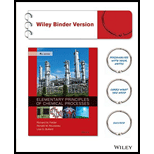
Concept explainers
(a)
Interpretation:
The resistance thermometer calibration formula for T (°C) in terms of r (ohm) should be derived.
Concept introduction:
The relationship between the temperature and the resistance should be written as follows:
Where, a and b are taken as the constants.
(b)
Interpretation:
The given gas law expression to an expression for n (kmol/min) in terms of P(mm Hg) T(°C) and V(m3/min) should be converted.
Concept introduction:
The given gas law needs to be equated to convert the expressions.
Here,
Conversion factors will be used to generate the desired conversions.
(c)
Interpretation:
The temperatures and pressures at point 1,2 and 3 should be determined.
Concept introduction:
The derived equation from part (a) must be used to solve the temperatures as:
For the pressure calculation, the following formula needs to be used:
(d)
Interpretation:
The molar flow rate of the combined gas stream should be calculated.
Concept introduction:
The point 1 with methane gas and point 2 with air are combined as the gas stream.
The molar flow rate at the two points should be calculated with following formula obtained in part (b):
The molar flow rate at two points should be added to get the molar flow rate of the combined stream.
(e)
Interpretation:
The reading of flowmeter 3 in m3/min should be cakculated.
Concept introduction:
The flowmeter at point three will give the volumetric flow rate of the combined gas which can be determined using following equation obtained in part (b):
From the equation:
(f)
Interpretation:
The total mass flow rate and mass fraction of the methane at point 3 should be calculated.
Concept introduction:
The mass flow rate is calculated as mass flown per unit time and the mass fraction is the ratio of mass flow rate of one component to the mass flow rate of total component mixture.
Want to see the full answer?
Check out a sample textbook solution
Chapter 3 Solutions
Elementary Principles of Chemical Processes, Binder Ready Version
 Introduction to Chemical Engineering Thermodynami...Chemical EngineeringISBN:9781259696527Author:J.M. Smith Termodinamica en ingenieria quimica, Hendrick C Van Ness, Michael Abbott, Mark SwihartPublisher:McGraw-Hill Education
Introduction to Chemical Engineering Thermodynami...Chemical EngineeringISBN:9781259696527Author:J.M. Smith Termodinamica en ingenieria quimica, Hendrick C Van Ness, Michael Abbott, Mark SwihartPublisher:McGraw-Hill Education Elementary Principles of Chemical Processes, Bind...Chemical EngineeringISBN:9781118431221Author:Richard M. Felder, Ronald W. Rousseau, Lisa G. BullardPublisher:WILEY
Elementary Principles of Chemical Processes, Bind...Chemical EngineeringISBN:9781118431221Author:Richard M. Felder, Ronald W. Rousseau, Lisa G. BullardPublisher:WILEY Elements of Chemical Reaction Engineering (5th Ed...Chemical EngineeringISBN:9780133887518Author:H. Scott FoglerPublisher:Prentice Hall
Elements of Chemical Reaction Engineering (5th Ed...Chemical EngineeringISBN:9780133887518Author:H. Scott FoglerPublisher:Prentice Hall
 Industrial Plastics: Theory and ApplicationsChemical EngineeringISBN:9781285061238Author:Lokensgard, ErikPublisher:Delmar Cengage Learning
Industrial Plastics: Theory and ApplicationsChemical EngineeringISBN:9781285061238Author:Lokensgard, ErikPublisher:Delmar Cengage Learning Unit Operations of Chemical EngineeringChemical EngineeringISBN:9780072848236Author:Warren McCabe, Julian C. Smith, Peter HarriottPublisher:McGraw-Hill Companies, The
Unit Operations of Chemical EngineeringChemical EngineeringISBN:9780072848236Author:Warren McCabe, Julian C. Smith, Peter HarriottPublisher:McGraw-Hill Companies, The





